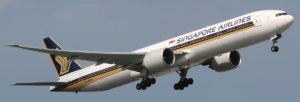Singapore Airlines has become the latest victim of the Boeing 777 engine woes. The engine issue occurred on Singapore Airlines Flight 368 from Singapore to Milan, Italy. Two hours after takeoff, the cockpit crew received a right side engine oil warning light. The flight returned to Singapore, and made an emergency landing to have the issue checked out. During the landing, the right engine caught fire on the runway, and quickly spread to the right wing. None of the planes 222 passengers and 19 crew members were injured, but the aircraft sustained heavy damage.
Emergency services quickly responding to the incident at Singapore’s Changi Airport . The fire was quickly extinguished with the passengers still on board as the aircraft sat on a taxiway. Nine hours later, the passengers later boarded another Boeing 777 aircraft, and were back on their way to Milan. This is just the latest in what has become a pattern of incidents with the popular Boeing airplanes engines.
Singapore Airlines latest with 777 engine woes
It was a General Electric GE90-115B model engine that caught fire on the Singapore Airlines flight. The Civil Aviation Authority of Singapore has announced it will launch an investigation into the accident. GE is also sending a team of representatives to the scene to help support the airline and investigators. The runway that the plane landed on was closed for about 5 hours following the incident. The engine fire follows two other major GE 777 engine fires over the course of the last year.
A Korean Air 777 had an engine fire on May 27, 2016. Smoke was reportedly seen coming from the aircrafts left engine just as it was about to takeoff. The flight from Tokyo Haneda Airport was bound for Gimpo International Airport in Seoul, South Korea. There were 302 passengers and 17 crew members on board that flight. Everyone got out of the plane, but 19 people were reportedly injured during the evacuation.
On September 8th, 2015, a British Airways 777 aircraft had an engine catch fire on takeoff. The flight from the McCarran International Airport in Las Vegas was headed for London Heathrow Airport. Following the incident, it was revealed that the FAA had previously issued a warning to Boeing. That warning four years earlier was that the GE90-85B engine had an unsafe condition. It was discovered that the compressor could possibly disintegrate and cause an explosion. This type of explosion could potentially propel debris at a high enough rate of speed to endanger the entire aircraft. General Electric released a statement that the British Airways 777 had a different version of its GE90-8FB engine. The National Transportation Safety Board stated that the Las Vegas incident occurred in the same way as mentioned in its warning.
